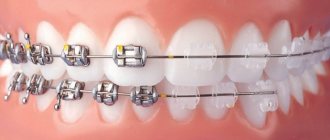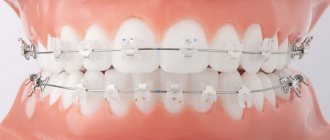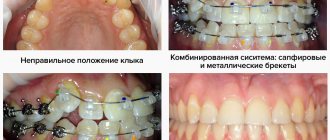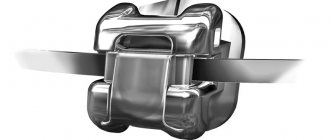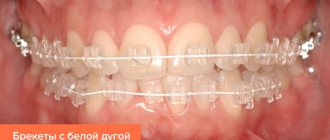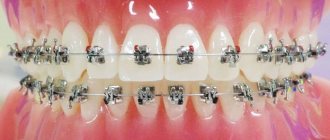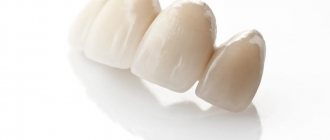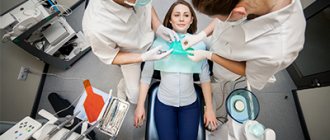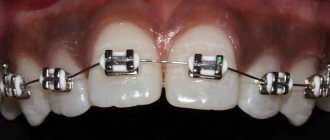Self-ligating braces are one of the modern types of dental correction. They have some advantages over traditional ligature ones. In some cases, self-ligating braces are used when complex pathology is detected, as the only method of treating the dentition without first removing the incisors.
Such systems are among the most common methods used in orthodontics. At the same time, self-ligating devices have a higher cost, in contrast to ligature (classical) types of braces.
The advantages of self-ligating braces according to reviews from orthodontists:
- Such systems adapt the teeth naturally, without damaging them with excessive pressure, that is, the dentition is corrected naturally.
- The system allows you to leave healthy teeth intact. The device adapts them and makes it possible to save them without prior surgical intervention.
- The use of such a device reduces the number of doctor visits by two to three times.
- They are quite convenient for patients.
Special elastic rubber rings are used as fastenings in classic braces. In newer models, the fastenings are replaced with metal micro-locks.
Types of ligature braces
Metal structures are classics, their effectiveness has been tested for decades. Of course, the appearance of these braces leaves much to be desired. However, due to its affordable price and high efficiency, this model still remains very popular. For those who are self-conscious about their smile, ceramic systems are offered. They are almost invisible, but their cost is much higher.
Ligature braces are superior to non-ligature braces in cost and practicality. However, in terms of convenience they are significantly inferior to other, more modern systems:
- In the first days after installation of such a device, the patient feels great discomfort in the jaw area. He has difficulty talking, eating and yawning.
- The elements of the device are massive. This makes daily cleaning difficult and worsens the appearance of the oral cavity.
- Due to the rapid wear of the ligatures, constant replacement is required, therefore, you have to frequently visit the dentist.
Non-ligature constructions
Just like ligature ones, they consist of an arc and fixing elements. The arc is fixed with metal micro-locks. The micro-lock cover is built into the bracket, so it is almost invisible. Systems are adjusted less frequently – approximately once every two to three months.
According to marketers, the treatment process is reduced by 20-30%. However, research has shown that this is just a marketing ploy. The duration of treatment does not depend on the type of braces.
Another myth is that self-ligating braces do not cause discomfort. This is explained by the fact that less pressure is exerted on the teeth compared to other types of systems. Elastic fastening ligaments do not allow high friction forces. As a result, the jaws do not suffer from excessive pressure. However, if the specialist is experienced and has installed the bracket system correctly, then even with a conventional device the patient will not feel any discomfort.
Stages of treatment
- Preparatory. The doctor does a visual examination and prescribes an x-ray. At this stage, you need to prepare the oral cavity: cure caries, remove teeth, have it professionally cleaned. The orthodontist plans the treatment and takes impressions to make the braces.
- Installation of the device. The orthodontist attaches the brackets to the dried surface of the teeth using photopolymer glue. Additional elements are fixed: springs, rings, hooks. At the last stage, the power arc is installed and secured.
- Treatment. After the braces are installed, the treatment process begins. At this time, it is necessary to regularly visit a doctor to monitor the correction process, professional teeth cleaning, and replacement of power arches. When using self-ligating braces, you need to come to the clinic once every 2-3 months.
- Removing the bracket system. The doctor removes the power arch and then uses tweezers to remove the braces.
- Retention period. The next 1-2 years are required to consolidate the results. For this purpose, non-removable retainers or removable devices (aligners, plates) can be used.
How do ligature-free braces work?
Crooked teeth can be treated with both ligature and non-ligature braces. In the first option, the doctor uses special rubber devices and a metal base to secure the teeth. This creates a reverse force from the jaw muscles, which allows the teeth to be aligned in the correct vertical position.
The difference between self-ligating braces and traditional braces is that they do not create additional pressure on the teeth, but simply fix the dentition. A straightening effect is created, as a result of which the teeth move much more easily.
Advantages of non-ligation braces:
- Aesthetic appearance. Fasteners that are located on the arc look more attractive in comparison with traditional metal fixtures.
- The curvature of the dentition is eliminated more easily due to the absence of friction.
- Getting used to the device in a short time.
- Teeth that interfere with correction are not removed, as was the case with ligature braces.
- Ligature-free braces do not cause mechanical damage to the mucous membrane and soft tissues of the oral cavity. The patient feels virtually no discomfort.
- There are no pain or complications with prolonged wearing.
- Can be removed and reinstalled in a short period of time.
- Patients who have been diagnosed with periodontitis should use only non-ligature braces when correcting their dentition.
- You can visit a personal specialist less often. To adjust the position of braces, it is enough to contact the orthodontist once every 60 days.
Indications for installation
Self-ligating braces are installed to correct the following anomalies:
- malocclusion - improper closure of teeth; metal models are used to correct complex malocclusions, which eliminates the need for surgery;
- curvature, uneven position, crowding of teeth or large gaps (three spaces) between them;
- unerupted (impacted) teeth – braces help to pull them out:
- disorders of the temporomandibular joint, causing difficult painful movement of the jaws, increased muscle tone;
- displacement of the dentition caused by prolonged absence of teeth, leading to facial asymmetry;
- to improve the appearance of the face in profile;
- in preparation for prosthetics or implantation to expand the gap between teeth, if the tooth has been missing for a long time and the gap has decreased.
The orthodontist decides together with the patient whether to choose self-ligating or ligature braces. The approach to selection should be individual, taking into account the characteristics of the existing pathology, aesthetic preferences and the cost of the design. Ligature-free braces are more expensive and do not require frequent visits to the doctor, so they are more often installed on adult patients. Children (not earlier than 8–9 years old and only on permanent teeth) and adolescents can have both types of braces installed, but they are still more often fitted with metal ligature models. Read more about braces for children here.
Ceramic and sapphire models are not suitable for children, as they are quite fragile and can injure a child if broken.
Non-ligature systems made of metal
Non-ligature metal braces are one of the most common types of devices in domestic dentistry. The only drawback of the system is the aesthetics of the design. But due to their high efficiency and increased durability, many patients do not attach much importance to their appearance.
- Model Damon 3MX. For many years it was considered one of the most advanced models of braces systems. The design does not have sharp protrusions, which ensures quick adaptation and no discomfort during the treatment process.
- Damon Q is another braces model from the same manufacturer. The system is customized to suit the jaw characteristics of each patient. An experienced doctor will be able to correctly predict treatment, and using this model, a positive result will be achieved in a short period.
- Smart Clip. Officially patented non-ligature system. Thanks to the design feature, it is possible to adjust the arc strength and, if necessary, change it in the desired direction to achieve maximum therapeutic results.
- Inovation K is a small bracket system that allows you to install an individual arch into the structure to suit the dimensions of the oral cavity of a particular patient. The developers used latches as fasteners, which additionally influence the arc and shorten the treatment period.
Possible complications
With proper installation, there are practically no complications, but in the first 1 - 2 weeks unpleasant symptoms may appear:
- discomfort in the oral cavity; with non-ligature models, which are small in size, this goes away quickly;
- speech impairment - disappears within 2 - 4 weeks; to speed up the process, you need to talk and read aloud more;
- dry lips – this symptom may bother you during the entire period of wearing braces; it can be reduced with the help of special moisturizing cosmetics;
- pain in the teeth - if the surrounding soft tissues are not inflamed, then this is due to the movement of the teeth in the desired direction; after some time, the tissues adapt to the impact, and the pain goes away;
- pain associated with irritation of the gums, tongue and inner surface of the cheeks; to prevent inflammation from developing, it is recommended to rinse your mouth with antiseptic solutions - infusion of chamomile flowers, calendula, Miramistin; over time all this passes;
- headaches - they are not so common, but sometimes wearing braces provokes their appearance; in such cases, you need to visit an orthodontist, make sure that the system is installed correctly, and then contact a neurologist.
Urgent medical attention is required if the following symptoms appear:
- redness, swelling of the gums, the appearance of ulcers in the mouth with an increase in body temperature, loosening of teeth, increasing pain - these signs appear as a result of improper installation of the system;
- the appearance of carious spots on tooth enamel.
Non-ligature ceramic systems
Such systems are developed on a ceramic basis: small crystals or granules. The size of the crystals directly affects the strength of the system - the smaller they are, the stronger. However, there is a minor drawback: small granules have lower transparency. Despite the fact that these braces are slightly stronger than metal ones, they look much more aesthetically pleasing. To increase strength, metal components are added to the material for making ceramic models.
Several famous ceramic models:
- Clarity SL. Such models use materials using aluminum oxide. This is the only model whose design uses a minimum amount of metal elements.
- Inovation C. A model that was designed relatively recently. It combines the advantages of a metal analogue of the same name and a wonderful aesthetic appearance. The design consists of a transparent ceramic material with a top layer of silicon oxide. Thanks to this composition, braces look attractive and do an excellent job of their main task - correcting the bite.
- Damon Clear. Braces that are practically invisible on the surface of the teeth. They are made from a special material – sapphire. Another significant advantage is that they do not change color under the influence of dyes.
PATIENTS' REVIEWS ABOUT SELF-LIGING BRACKETS ACCORDING TO VIP PROTOCOL.
Look at the review of our patient, actress and TV presenter Yana Troyanova, about teeth straightening in our clinic using the VIP protocol.
Teeth straightening and bite correction with self-ligating braces from one of the best orthodontists in Moscow.
Orthodontic treatment at the Bionic Dentis clinic is carried out by Dr. Ovsyanik Alexander Vadimovich, an orthodontist with 11 years of experience.
According to an independent study, Alexander Vadimovich Ovsyanik ranks third in the ranking of orthodontists in Moscow.
Which are better, ligature or non-ligature braces?
Some dentists believe that ligature-free braces are much better, since the design was created using technology that appeared not so long ago. The attachment of braces has really changed. It is now much easier for specialists to work with such models. But, from the point of view of biomechanics, arches in two designs from different generations work absolutely the same. It is difficult to assess the separation effectiveness of one bracket system from another. It all depends on the pathology that the patient suffers from. Based on this, the choice is made.
A specialist should choose a model of braces. He will recommend a suitable device depending on the individual characteristics of the client. To do this, the specialist studies the clinical picture of the patient’s dentition. Based on the results and analyses, the orthodontist offers several options for devices to choose from. Now the client chooses from the available assortment, justifying his choice with financial capabilities and personal wishes.
How to care for braces?
Regardless of the type of braces used, ligature or non-ligature, they require careful care. It should be noted that you cannot limit yourself to brushing your teeth in the morning and evening. Due to the fact that braces have protrusions and different methods of fastening, cleaning out food debris becomes problematic.
According to the doctor's recommendations, you will need to purchase a special dental solution, a large brush, a small brush and dental floss from the pharmacy. Oral hygiene will have to be done after every meal. First of all, you need to use a large brush that will remove large food debris from the tooth surface. Then you can move on to a fine brush. Using such a hygienic tool, you can remove germs in hard-to-reach places. The final stage is using dental floss. Only after such manipulations can oral hygiene be completed. One procedure takes on average 10-15 minutes after each meal. On average, it will take 30-40 minutes a day to clean your braces and mouth from bacteria.
Please note: braces can only be installed on completely healthy teeth. If treatment is required for periodontitis or other diseases of the teeth and gums, these problems are first eliminated, and only then the system is installed.
Sincerely, Levin D.V., chief physician
Contraindications
The installation of self-ligating structures also has contraindications. They can be absolute (correction is never carried out) and relative (correction can be carried out under certain conditions or after some time).
Absolute contraindications include:
- some common diseases that lead to decreased immunity and increased risk of infection of periodontal tissues - diabetes mellitus, immunodeficiency, blood diseases, cancer;
- severe chronic infections - AIDS, open tuberculosis;
- mental illnesses that prevent the patient from contacting the orthodontist, epilepsy;
- changes in the bone tissue of the jaw (atrophy, osteoporosis) - a thinned bone may not withstand the load;
- the absence of several teeth in the dentition at once - treatment should be carried out by an orthodontist together with an orthopedist.
Relative contraindications:
- infectious and inflammatory diseases of the oral cavity, teeth and periodontal tissues - stomatitis, caries, periodontitis;
- degenerative-dystrophic periodontal diseases - periodontal disease;
- the presence of implants and fixed dentures in the dentition - the issue of installing braces should be decided by the orthodontist together with the orthopedist;
- bruxism – grinding of teeth, mainly during sleep;
- allergies to dental materials – selection of materials will take some time;
- pregnancy and lactation;
- any acute diseases and exacerbation of chronic diseases.
